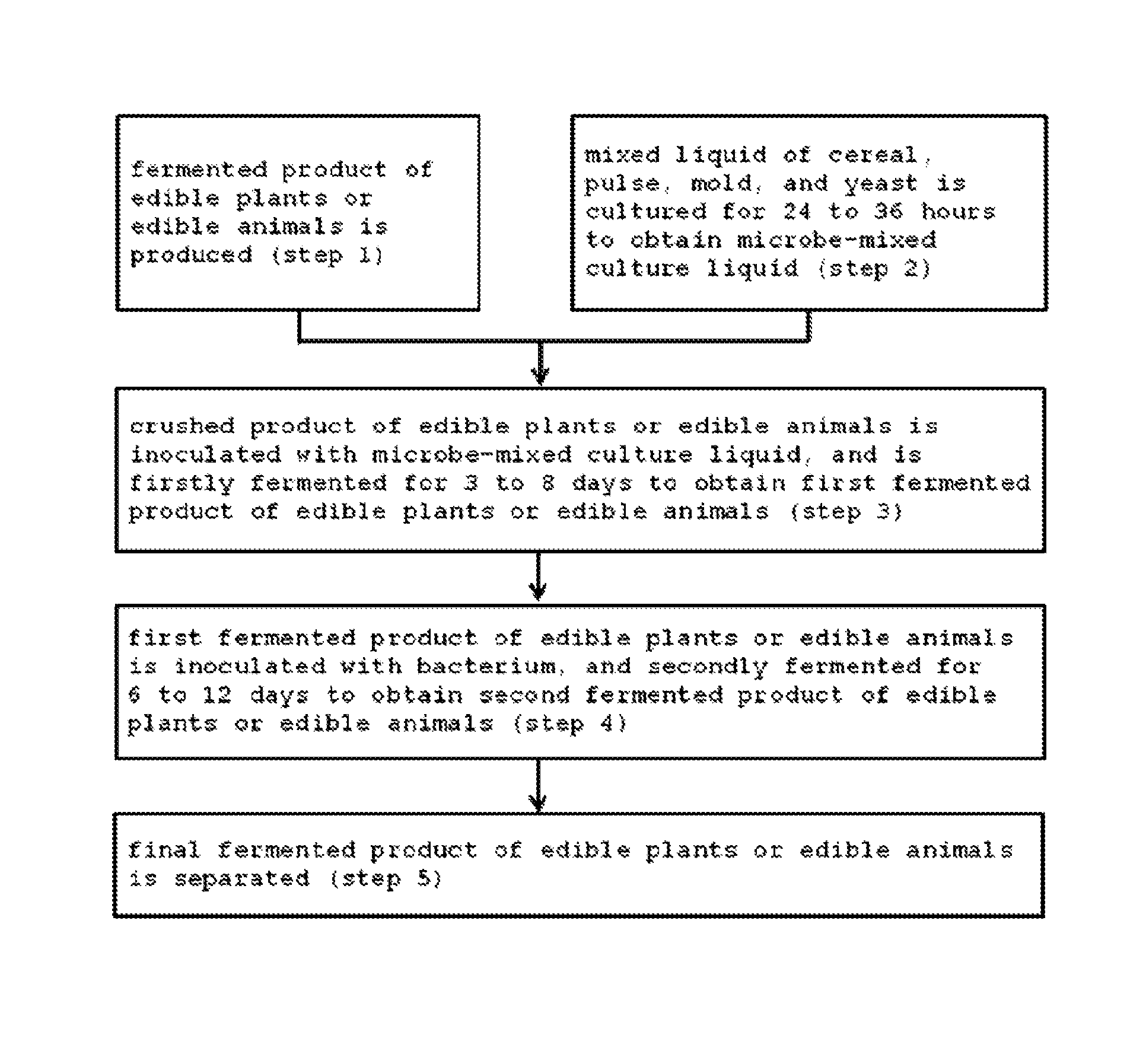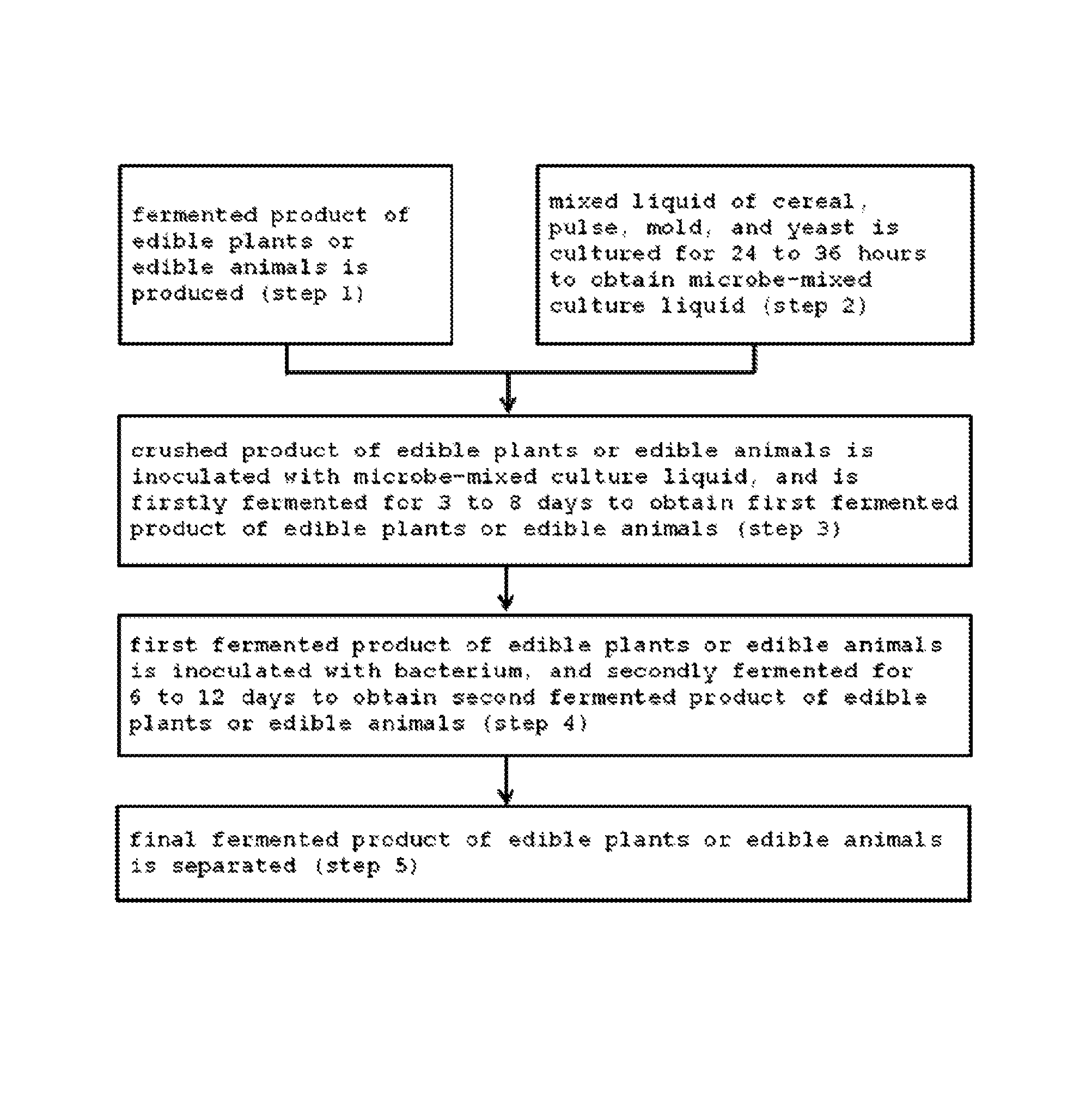Method for producing fermented edible plants or edible animal/plants, fermented edible plants or edible animal/plants produced by same, and foods containing same
a technology of edible plants and edible animals, which is applied in the direction of wort preparation, fruit/vegetable preservation using acids, food preparation, etc., can solve the problems of food deterioration, food pathogens, serious disease and death, etc., and achieve the effect of reducing the fermentation period of edible plants or edible animals, reducing the number of anaerobic microorganisms, and effectively inhibiting invasion or proliferation
- Summary
- Abstract
- Description
- Claims
- Application Information
AI Technical Summary
Benefits of technology
Problems solved by technology
Method used
Image
Examples
example 1
Manufacture of a Fermented Product of Edible Plants-1
[0077]20 kg of grapes, 10 kg of strawberries, 10 kg of oriental melons, 10 kg of dropworts, 10 kg of broccolis, 10 kg of crown daises, 10 kg of kales, 5 kg of radishes, 2 kg of cucumbers, 2 kg of pears, 2 kg of balloonflowers, 1 kg of kelps, 1 kg of slander glassworts, 2 kg of yams, 1 kg of garlics, 1 kg of oak mushrooms, 1 kg of schizandra, 1 kg of mate, and 1 kg of red peppers were put in a water immersion tank, washed by clean water, and dehydrated. Then, the dehydrated materials were cut-crushed into a size of 5 to 10 cm or pulverized to provide a crushed product of edible plants, and the obtained crushed product was placed in a fermentation tank.
[0078]Before the above described process, 5 kg of rice bran and 5 kg of wheat bran were mixed with each other and the mixture was steam-sterilized and cooled to room temperature. Then, 0.7 kg of unrefined sugar, 0.4 kg of Aspergillus niger, 0.4 kg of Aspergillus oryzae, and 0.8 kg of ...
example 2
Manufacture of a Fermented Product of Edible Plants-2
[0080]20 kg of adlay, 15 kg of yam, 8 kg of squash, 8 kg of strawberry, 8 kg of paprika, 2 kg of angelica keiskei, 2 kg of slander glasswort, 4 kg of asparagus, 4 kg of lotus root, 4 kg of apple, 4 kg of potato, 4 kg of kidney beans, 2 kg of ginseng, 2 kg of chestnut, 1 kg of red pepper, 1 kg of cucumber, 2 kg of garlics, 2 kg of radishes, 2 kg of astragali radix, 2 kg of oyster mushrooms, 1.5 kg of mugwort, 1 kg of pine needles, 1 kg of ginger, 1 kg of lemon, and 0.5 kg of green perilla were placed in a water immersion tank, washed by clean water, and dehydrated. Then, the dehydrated materials were cut-crushed into a size of 5 to 10 cm or pulverized to provide a crushed product of edible plants, and the obtained crushed product was placed in a fermentation tank.
[0081]Before the above described process, 5 kg of unpolished rice, and 5 kg of barley were washed, and mixed with each other, and the mixture was steam-sterilized and cool...
example 3
Manufacture of a Fermented Product of Edible Plants-3
[0084]23 kg of rice bran, 20 kg of unpolished rice, 20 kg of barley, 15 kg of adlay, 10 kg of soybeans, 5 kg of buckwheat, 3 kg of carrots, 3 kg of squash, 3 kg of sweet potato, 2 kg of tomatoes, 2 kg of broccoli, 2 kg of paprika, and 2 kg of balloonflowers were placed in a water immersion tank, washed by clean water, and dehydrated. Then, the dehydrated materials were cut-crushed into a size of 5 to 10 cm or pulverized to provide a crushed product of edible plants, and the obtained crushed product was steam-sterilized, and placed in a fermentation tank.
[0085]10 kg of the microbe-mixed culture liquid A and 10 kg of the microbe-mixed culture liquid B, fermented and cultured in Examples 1 and 2, were mixed with each other. Then, the mixture was transferred to the fermentation tank containing the crushed product of the edible plants, and mixed with the crushed product. The resultant mixture was firstly fermented at 25 to 27° C. for 8...
PUM
| Property | Measurement | Unit |
|---|---|---|
| size | aaaaa | aaaaa |
| size | aaaaa | aaaaa |
| weight | aaaaa | aaaaa |
Abstract
Description
Claims
Application Information
 Login to View More
Login to View More - R&D
- Intellectual Property
- Life Sciences
- Materials
- Tech Scout
- Unparalleled Data Quality
- Higher Quality Content
- 60% Fewer Hallucinations
Browse by: Latest US Patents, China's latest patents, Technical Efficacy Thesaurus, Application Domain, Technology Topic, Popular Technical Reports.
© 2025 PatSnap. All rights reserved.Legal|Privacy policy|Modern Slavery Act Transparency Statement|Sitemap|About US| Contact US: help@patsnap.com


